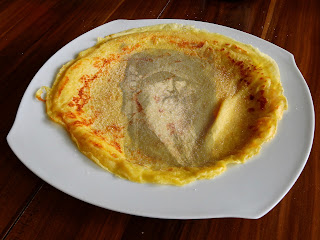I Saw Odin in a Crepe
There are days when you shouldn’t let me cook. Those days are the days when I get silly titles for this blog, which is why you get the title: “I Saw Odin in a Crepe.”
The title occurred to me while I was thinking about how many folks seem to think because they see a raven, they’re being watch by Odin, or they see Thor or Mjolnir in the clouds, or they’re convinced that they hear wights whispering in the trees. Now, I’m willing to put aside my disbelief for some things, but many things do have scientific explanations.
Jesus on a Grill Cheese Sandwich, or Pareidolia
 |
| By Viking 1, NASA [Public domain], via Wikimedia Commons |
I’m sure you’ve read stories about someone seeing Jesus on a grill cheese sandwich, or Mary on a tortilla. Maybe you’ve see how people are convinced they see they see a rat or a tomb or Gandhi on the surface of Mars. When people think they see a face on an inanimate object, the term is called pareidolia. If you see a pattern in something that is more or less random, the term is called apophenia.
Both pareidolia and apophenia are normal human psychological behaviors. In other words, if you experience it, you’re normal. There have been several theories as to why this occurs. Carl Sagan actually suggested that it was an evolutionary development so people could recognize whether someone was a friend at a distance or an enemy. Most likely we’ve evolved to recognize faces because we’re social animals. We’ve evolved to look for our parents’ faces and to recognize them once they’ve been established as our caregivers. That way, when we see other people, who may or may not be friendly, we can differentiate between parents and others.
So, when you see Thor’s shape in the clouds, a cloud that looks like Mjolnir, or Odin in a crepe, you’re dealing with pareidolia. It doesn’t mean you’re gullible or stupid. It actually means you have a well-connected brain and you can see patterns that some other folks don’t.
Apophenia, or Trying to See a Pattern in a Random Data Set
Like pareidolia, apophenia is trick that humans evolved so that we could actually see a pattern in things and make assumptions as to what might happen next. The problem with apophenia is that we see patterns where none really exist. It’s a mode of superstitious behavior that we exhibit when we do something and something completely unrelated to it happens. For example, you see a raven and think of Odin, and the next thing that happens is you find a $10 bill on the ground. One might say that Odin sent the raven as a good luck omen. Next time you notice a raven, you miss getting hit by a car. Now, you’re sure that it is Odin.
But wait a second. Aren’t ravens fairly commonplace? How many times have you seen a raven and nothing happened? (Why would you remember it, since nothing happened?) My point is that the randomness of seeing a raven and having good things occur is that: simply random.
Now, if the raven were to come over to you and start a conversation, this would change from pareidolia to either you’ve got some good hallucinations going (stay off the acid), or one of Odin’s birds have shown up to chat.
It’s Not Just Visual, Either
 |
| Man in the moon? |
Apophenia and pareidolia aren’t just linked to our sight. We can think we hear people talking when we’re hearing white noise or strange sounds. It’s pretty common, actually. You’ve heard the term, “babbling brook?” Well, it’s easy to think you’ve heard voices listening to a brook. Sometimes, I swear I hear a radio or a song when the fans are on at my house, when it is just the noise from the fans.
Our brains are trying to make sense out of a random noise, so we start “hearing” a pattern in the noise, even though we don’t.
Where am I Going with This?
You may wonder at some point why I’m bringing all this up. The first reason is fairly simple. I get tired of people announcing that this god or that goddess has shown their favor because they saw something that is most likely pareidolia. Or maybe you looked in the mirror at night and thought you saw your fylgia looking back at you (again, pareidolia). If it’s dark and we see something, our minds are quick to fill in the image we saw.
The second reason is to educate you on how your mind works, so you don’t mistake simple tricks of your mind as being “magic.” That way, should you really have contact with gods or wights, you know it’s not just a simple trick of your mind.


